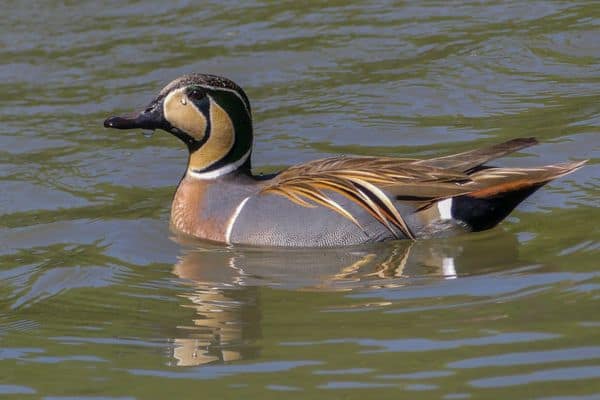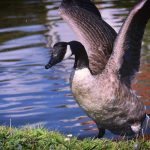Common Name: Baikal Teal
Scientific Name: Sibirionetta formosa| Size | Diet | Range in Hawaii | Status in Hawaii |
|---|---|---|---|
| 11.75 in. - 15.75 in. | seeds, grain, and water plants. | Oahu, Maui, and the Big Island | least concern |
The Baikal teal is a small dabbling duck that breeds in eastern Russia and winters in East Asia. It is known for its striking appearance, with a bright green patch on its head and a distinctive, white crescent-shaped patch on its face.
The Baikal teal is a migratory species, and during the breeding season, it can be found in wetlands, marshes, and wooded areas in eastern Russia. In the winter, the birds migrate south to East Asia, where they can be found in a variety of habitats, including rice paddies, shallow ponds, and estuaries.
Baikal teal

Appearance
The Baikal teal is a small, dabbling duck with a distinctive appearance. They have a height ranging from 11.75 to 15.75 inches. The male has a bright green patch on its head, a white crescent-shaped patch on its face, and a spotted pink breast.
It also has long, drooping scapular feathers and white bars on its sides. The female is mostly brown, but has a white spot near the base of its bill and a hint of the male’s facial pattern.
Both sexes have a dark crown and weigh an average of one pound. The Baikal teal’s striking appearance makes it a highly valued species among birdwatchers and nature enthusiasts.
Diet
The Baikal teal consists mainly of plant matter, including seeds, grain, and water plants. They also consume snails, insects, and other small aquatic invertebrates.
During the breeding season, they may also eat small fish and amphibians. Baikal teals are dabbling ducks, which means they feed by tipping their head down into the water and grazing on the surface or diving briefly to capture prey.
Their diet is an important factor in their ecology and conservation, as habitat loss and pollution can impact the availability of the food sources they rely on.
Behavior

The Baikal teal is a social and gregarious bird species that typically forms large flocks outside of the breeding season. They are known for their distinctive flight pattern, which includes rapid wing beats interspersed with gliding.
During the breeding season, males perform elaborate courtship displays to attract females, including head bobbing, wing flapping, and vocalizations. Baikal teals are also known for their strong migratory instincts, traveling long distances between their breeding and wintering grounds.
They are generally diurnal, feeding during the day and resting at night. Baikal teals are also adapted to life in the water, with waterproof feathers and webbed feet that allow them to swim and dive for food.
Overall, the behavior of the Baikal teal is an important factor in its ecology and conservation, as understanding its behavior can help to inform management strategies and conservation efforts.
Nesting
The Baikal teal typically breeds in wetlands, marshes, and wooded areas. The breeding season begins in late May or early June, with males performing elaborate courtship displays to attract females.
The female selects a nest site, usually in a concealed location near water, and constructs a shallow depression lined with grasses and other vegetation. She lays a clutch of 6-15 eggs, which she incubates for around 25 days.
After hatching, the ducklings are precocial, meaning they are able to walk and swim almost immediately. The female leads them to water, where they feed on insects and other small invertebrates. The ducklings fledge and become independent after around 40-45 days.
Habitat

The Baikal teal inhabits a variety of wetland habitats, including wetlands, marshes, and wooded areas during the breeding season. During the winter, they migrate south to East Asia and can be found in habitats such as rice paddies, shallow ponds, and estuaries.
Baikal teals prefer shallow water with an abundance of aquatic vegetation, which provides cover and food sources. They are also known to use artificial wetlands, such as rice paddies and reservoirs, as habitat.
Range
In recent years, several sightings of the Baikal teal have confirmed its occurrence on occasion in the Hawaiian Islands. The species has been sighted on Oahu, Maui, and the Big Island, indicating that it may occur on multiple islands in Hawaii.
Conservation Status
The Baikal teal is considered a species of “Least Concern” by the International Union for Conservation of Nature (IUCN) due to its large global population and wide distribution. However, populations have declined in recent years due to habitat loss and hunting in its native range in eastern Russia.
The Baikal teal is also listed in Appendix II of the Convention on International Trade in Endangered Species (CITES), which regulates international trade in the species to ensure that it is not threatened by overexploitation.
Conserving the Baikal teal requires protecting wetland habitats and regulating hunting practices to ensure its survival for future generations.
Interesting Facts
1. Known for their striking appearance
The Baikal teal is known for its striking appearance, with a bright green patch on its head, a white crescent-shaped patch on its face, and a spotted pink breast.
2. They are highly migratory
Baikal teals are highly migratory, traveling long distances between their breeding and wintering grounds.
3. They are social and gregarious bird species
The Baikal teal is a social and gregarious bird species that typically forms large flocks outside of the breeding season.
4. Highly valued species
The Baikal teal is a highly valued species among birdwatchers and nature enthusiasts due to its striking appearance and migratory behavior.
Frequently Asked Questions
1. What is their lifespan?
Baikal teals can live up to 10 years in the wild. However, their lifespan can be affected by a variety of factors, including habitat quality, predation, and hunting pressure. In captivity, Baikal teals have been known to live up to 20 years.
2. How do they communicate?
Baikal teals communicate through a variety of vocalizations, including quacks, whistles, and grunts. During the breeding season, males use vocalizations to attract females and establish territories, while females use vocalizations to communicate with their offspring and other females.
Baikal teals also use body language, such as head bobbing and wing flapping, to communicate with each other. Additionally, visual cues, such as the bright green patch on the male’s head, may also play a role in communication.
3. What is their historical and cultural significance?
The Baikal teal (Sibirionetta formosa) has historical and cultural significance in its native range in eastern Russia and East Asia, where it is celebrated as a symbol of beauty and grace. In Japan, the Baikal teal is known as the “kouyou” or “autumn leaf,” and its striking appearance is associated with the changing colors of the autumn leaves.
The Baikal teal is known as “chilgoza” or “seven-son-in-law” in Korea and is featured in traditional Chinese and Japanese art as a symbol of peace and tranquility.




